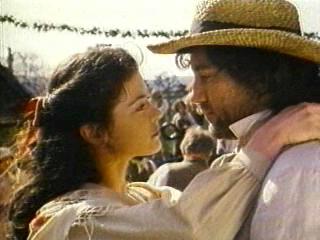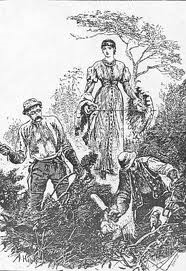I’ve been reading The Return of the Native
 Sexual politics, revenge, thwarted love, beautiful women, a deeply flawed heroine, illicit sex, a diamond merchant, angry teenagers, ‘The Return of the Native’ has all the makings of a fabulous American soap opera. It first appeared as a serial in the sensationalist magazine, ‘Belgravia’, in 1878. Hardy had difficulty finding a publisher for the novel and had to tack on a happy ending to keep the readers happy which was not in his original plan and also, I imagine, up the dramatic stakes. It’s a fantastic read and particularly interesting, I think, because of the role played by the Dorset heathland.
Sexual politics, revenge, thwarted love, beautiful women, a deeply flawed heroine, illicit sex, a diamond merchant, angry teenagers, ‘The Return of the Native’ has all the makings of a fabulous American soap opera. It first appeared as a serial in the sensationalist magazine, ‘Belgravia’, in 1878. Hardy had difficulty finding a publisher for the novel and had to tack on a happy ending to keep the readers happy which was not in his original plan and also, I imagine, up the dramatic stakes. It’s a fantastic read and particularly interesting, I think, because of the role played by the Dorset heathland.
The Industrial Revolution pretty much passed Dorset by. Dorset had no coal or large cities, and it remained an agricultural economy even in Hardy’s day. Hardy’s novel concerns a truly rural community, the kind that hadn’t changed much since the Middle Ages.
Egdon Heath dominates ‘The Return of the Native’ and, as luck has it, I frequently stay very  close to the part of Hardy’s heathland that lies east of Dorchester and west of Wool, Hardy’s Egdon Heath, and have walked the area in all seasons. In fact, I’m there at this moment. It is a bleak but beautiful, not particularly welcoming place, and it is volatile. In Summer unexplainable fires break out all over Dorset, but the heath regrows, it reinvents itself.
close to the part of Hardy’s heathland that lies east of Dorchester and west of Wool, Hardy’s Egdon Heath, and have walked the area in all seasons. In fact, I’m there at this moment. It is a bleak but beautiful, not particularly welcoming place, and it is volatile. In Summer unexplainable fires break out all over Dorset, but the heath regrows, it reinvents itself.
You wander through dark swathes of purple heather, past outcrops of prickly gorse that fill the air thickly with the smell of almonds as the blossoms are warmed by the sun. Steep ridges and dips snake with sandy white rabbit paths winding between the furze, gravelly where the rain forms rivulets down to a sucking bog that keeps your boots if you let it. Even on a sunny day, there’s a sense of foreboding or possibly even a sense of loss. It’s almost as if the heath cares for no-one–get you gone, do as you will, leave me alone, it’s saying. This is not cosy country; it’s not grand scenery, but it is beautiful in its bleakness, in its lack of welcome. If you relish isolation, it’s a wonderful place because isolation often means tucking yourself away into a tight space, out of sight, but here you have space to cast your eyes, feel the wind, stride and jump or sit on a tussock and daydream. It is often totally quiet except for the heath ponies snorting; the whining wind; the occasional truck steaming along the dead straight Roman road, and it is motionless unless you catch a glimpse of one of the enormous herds of Sika deer that fly across the purple lake. An adder catches your eye, slithering across the sandy soil between the knotty heather and the stunted gorse, and the wind sweeps across the vast expanse of treeless land, moaning, relentlessly chill.
 Dorset heathland is not a natural environment; it was entirely man-made over 4,000 years ago in the Bronze Age. Since then it has been carefully maintained by people throughout the ages. Originally it was planted with indigenous trees – pines, beech, elm, hazel and oak. Trees were cleared in order to plant crops and the timber was used for building materials and fuel. Grazing animals prevented the regrowth of trees. Gradually the fertility of the soil became reduced and it became acidic, useless for crops but great for heather and gorse. If it were not maintained, even now, it would revert to woodland – pines and beeches would sprout up and the ubiquitous rhododendron would invade the area. In the Middle Ages, the heathland became ‘common’ and people were given rights to gather peat, graze stock, gather heather for roofing and animal bedding, and right up to the 1930s the Dorset heathland formed an important role in the rural economy and local communities took a living from it. In 1919 the Forestry Commission were told to plant trees, and inevitably the way of life changed as gas, coal and electricity replaced peat as fuel. It wasn’t until the 1980s that Dorset’s heathlands were protected but by that time only 15% remained.
Dorset heathland is not a natural environment; it was entirely man-made over 4,000 years ago in the Bronze Age. Since then it has been carefully maintained by people throughout the ages. Originally it was planted with indigenous trees – pines, beech, elm, hazel and oak. Trees were cleared in order to plant crops and the timber was used for building materials and fuel. Grazing animals prevented the regrowth of trees. Gradually the fertility of the soil became reduced and it became acidic, useless for crops but great for heather and gorse. If it were not maintained, even now, it would revert to woodland – pines and beeches would sprout up and the ubiquitous rhododendron would invade the area. In the Middle Ages, the heathland became ‘common’ and people were given rights to gather peat, graze stock, gather heather for roofing and animal bedding, and right up to the 1930s the Dorset heathland formed an important role in the rural economy and local communities took a living from it. In 1919 the Forestry Commission were told to plant trees, and inevitably the way of life changed as gas, coal and electricity replaced peat as fuel. It wasn’t until the 1980s that Dorset’s heathlands were protected but by that time only 15% remained.
In the Return of the Native, Egdon Heath is the main character of the novel, rising above  humanity, immortal. The heath symbolises the human condition, the world of man, which is interesting since it is man-made – I wonder if Hardy was aware of that. I think not since he says in chapter 1:
humanity, immortal. The heath symbolises the human condition, the world of man, which is interesting since it is man-made – I wonder if Hardy was aware of that. I think not since he says in chapter 1:
“The untameable, Ishmaelitish thing that Egdon now was it had always been. Civilization was its enemy: and ever since the beginning of vegetation its soil had worn the same antique brown dress, the natural and invariable garment of the particular formation. . . . The great inviolate place had an ancient permanence which the sea cannot claim.”
Hardys’ attitude to the heath is peaty rich in its complexity. The characters differ in the ways in which they react to it but they are all influenced by it. Not one of them is immune to its influence. The heath moves the characters to love or hate or into despair and death. It holds the whole action in its palm and it wraps the characters in its arms, often too tightly, and casts them aside like dolls.
Through the heath, Hardy shows us the real circumstances in which man lives. What the individual may feel about the heath is irrelevant because he never escapes it. Man is insignificant in relation to this heath that has continued for generations. It is permanent, man is not.
 Those that understand the heath, like Clym Yeobright, realise that man is subordinate to nature, and they love the heath; for them it is home. Thomasin Yeobright, a simple girl brought up on the heath, sees it as a ridiculous wild thing but wouldn’t want to be anywhere else. The nineteen year old Eustacia Vye, on the other hand, who is in a desperate state of rebellion and seeking escape from the heathland at all costs, longing for a ‘better’ life; for her the heath is a prison and offers only the illusion of escape, nothing is ever tangible, and the heath is powerful and provides endless obstacles.
Those that understand the heath, like Clym Yeobright, realise that man is subordinate to nature, and they love the heath; for them it is home. Thomasin Yeobright, a simple girl brought up on the heath, sees it as a ridiculous wild thing but wouldn’t want to be anywhere else. The nineteen year old Eustacia Vye, on the other hand, who is in a desperate state of rebellion and seeking escape from the heathland at all costs, longing for a ‘better’ life; for her the heath is a prison and offers only the illusion of escape, nothing is ever tangible, and the heath is powerful and provides endless obstacles.
Whether you are born and bred on the heath does seem to determine your outcome in the novel. It’s an outsider, insider issue. Eustacia, an outsider who has been forced to stay with her grandfather on the heath, longs for the sophistication of Paris (and would make do with the sophistication of Weymouth at a pinch – she wouldn’t if she’d been there recently). For her ‘Egdon is my Hades’; she hates it with all her being; it haunts her and she cannot escape it however hard she tries. Her hatred and disgust for the heath are ardent. But perhaps Eustacia has a great deal more in common with the heath than she realises: they are both dark, volatile and inscrutable; they both have a hidden side. To Diggory Venn, the reddleman in love with Thomasin, it is home and he knows every path and hollow; he can run through it at night and in the worst of weather and he loves it. Diggory has the ability to appear on the heath without warning like a ghost or a messenger of the gods with his red skin, stained by the reddle used for marking sheep. To Clym, returned from Paris, (he is the native returned of the title), it is home; he is a child of the heath and he too doesn’t wish to leave. Mrs. Yeobright, his mother, is superior to the heathland rustics and educated, and she is appalled when Clym becomes a furzecutter reliant on the heath for his living; she dies of heat and exhaustion, the heath has killed her. Damon Wildeve is not from the heath and he weaves all sorts of schemes and plans, one of which is to escape with Eustacia but he dies in an attempt to rescue her. The heath kills him too.
In the valleys of the heath nothing save its own wild face was visible at any time of day … None of its features could be seen now, but the whole made itself felt as a vague stretch of remoteness. … Red suns and tufts of fire one by one began to arise, flecking the whole country round.
And that’s at the start of the novel, describing the bonfires on Guy Fawkes night. The heath is a wild, dark place that sucks all light into its blackness. The heath outlasts everything. It doesn’t age. It is immortal. A god. And the people tinkering around on the heath are entirely under its control and at its mercy.
My sister says this part of the heath is haunted. I’m not sure who by but I am planning to go up there tonight when it’s dark. I’ll let you know how I get on.
[My sister and I went up there together last night. It was very dark and so silent. Not windy. Quite cold. We walked a short way with torches. Impossible to see very far. No moon. It is a scary place to be at night. You sense the heath as a being. Malign? Yes, maybe. But that’s just me, my sister disagrees, perhaps because she goes there frequently in daytime and knows it well. No ghosts though.]
If you’re interested in Hardy you might like my post on The Mayor of Casterbridge.
